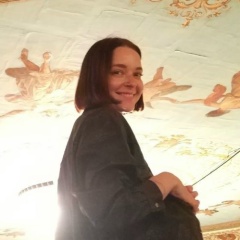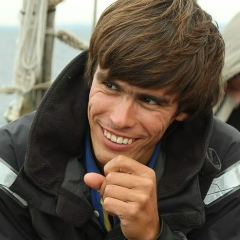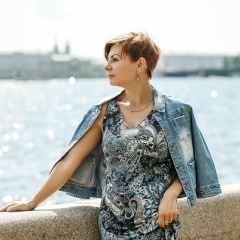Хочу поделиться текстом, который [id37227927|@nikita_pirogov] написал про мою работу. В принципе, это так же похоже на описание моего майянского кина или на описание моей жизни/кредо вообще, но формально - это про фотографию. Когда кто-то называет то, что я делаю, признавая это во всех подробностях - я испытываю удивительное облегчение от того, что меня видят такой, какая я есть. Спасибо тебе, Никита, за это чувство.
"Анна Харина
Анна Харина в своей работе раскрывает современное женское восприятие. Женская фотография Хариной с одной стороны не идет на поводу у современных трендов феминизма, не является агрессивной и воинственной, с другой стороны не вписывается в патриархальную модель мира с ее принуждением женщин к смирению и подчинению мужчине. Харина работает с портретом, раскрывая простоту и открытость, чувственность ее героев и героинь. Ее портреты полны огня, страсти, эмоций, переживаний. Она снимает интуитивно, выявляя в героях истинность и чистоту чувства. Взаимодействуя с героями через эмпатию и сострадание, Харина раскрывает прежде всего чувственность телесную, оголяя тем самым душевные состояния. Но желание у Хариной носит характер не чисто сексуальный, это скорее потребность во взаимодействии, особый вид коммуникации через фотографию, который подобен танцу. Харина метафорически танцует со своими героями, проживая вместе с ними их истории, взаимодействуя с ними откуда-то глубоко изнутри. Герои Хариной испытывают самые разные состояния, и она принимает их, подобно мудрой праматери, знающей своих детей. Она не судит и не удивляется граням человеческого переживания, поскольку осознает единство формы и содержания, что позволяет ей осознавать жизнь и человека как чувственно, так и духовно. Харина любуется красотой и телесностью, как мужской, так и женской. Танец Хариной с ее героями, не смотря на всю его остроту и близость, исходит из некоего потаенного источника, которым является, все же, сердце. Потребность сердечного взаимодействия у Хариной происходит из необходимости исцеления и единения противоположных начал. Не смотря на всю внешнюю страстность и эмоциональность, Харина в движении пребывает в покое, она осознает что как женское порождает мужское, так и мужское создает женское, и они не могут существовать друг без друга. Подобно ритуальному танцу у костра смерти (чувства), Харина ищет возможности слиться, пережить душевное слияние со своими героями, чтобы ощутить полноту и исцелить внутреннюю несвободу, чтобы убрать зажим и достигнуть естества, которое обретается посредством доверия и освобождения на телесном и духовном планах. Харина принимает суть своих героев – как внешнюю, так и внутреннюю. Она словно занимается с ними любовью – принимая как и прекрасное что в них есть, так и безобразное, или то, что они считают таковым, но что по ее мнению таковым не является. Харина любит фотографию, любит людей, любит чувствовать и осознавать себя, других и мир вокруг через сердечное проживание момента со-бытия. В мире, полном рассудочности и анализа, сдерживающем поток чувств, и в мире, где чувства неумелы, не взрощены и загублены в самом начале их возникновения, Харина берется за чувственное целительство и воспитание: она и взращивает, и укрощает, и оберегает, и направляет, и следует и любит, все время любит. Она танцует не партию андрогина, и не партию мужчины. Харина ведома своими героями, она дает им возможность показать ей себя, и все же, она знает, что конечным пунктом, целью взаимодействия является Любовь. Позволяя своим героям привести ее туда, где любовь была бы ощутима, она приводит туда и своего зрителя. И в действии она бездействует, волнуясь, пребывает в покое. Качаясь на волнах чувства, осознавая что источник бытия – как телесного, так и духовного, и причина, по который мы существуем – это Любовь, Харина созерцает мир и людей, принимая их и себя в своем несовершенном совершенстве."
"Анна Харина
Анна Харина в своей работе раскрывает современное женское восприятие. Женская фотография Хариной с одной стороны не идет на поводу у современных трендов феминизма, не является агрессивной и воинственной, с другой стороны не вписывается в патриархальную модель мира с ее принуждением женщин к смирению и подчинению мужчине. Харина работает с портретом, раскрывая простоту и открытость, чувственность ее героев и героинь. Ее портреты полны огня, страсти, эмоций, переживаний. Она снимает интуитивно, выявляя в героях истинность и чистоту чувства. Взаимодействуя с героями через эмпатию и сострадание, Харина раскрывает прежде всего чувственность телесную, оголяя тем самым душевные состояния. Но желание у Хариной носит характер не чисто сексуальный, это скорее потребность во взаимодействии, особый вид коммуникации через фотографию, который подобен танцу. Харина метафорически танцует со своими героями, проживая вместе с ними их истории, взаимодействуя с ними откуда-то глубоко изнутри. Герои Хариной испытывают самые разные состояния, и она принимает их, подобно мудрой праматери, знающей своих детей. Она не судит и не удивляется граням человеческого переживания, поскольку осознает единство формы и содержания, что позволяет ей осознавать жизнь и человека как чувственно, так и духовно. Харина любуется красотой и телесностью, как мужской, так и женской. Танец Хариной с ее героями, не смотря на всю его остроту и близость, исходит из некоего потаенного источника, которым является, все же, сердце. Потребность сердечного взаимодействия у Хариной происходит из необходимости исцеления и единения противоположных начал. Не смотря на всю внешнюю страстность и эмоциональность, Харина в движении пребывает в покое, она осознает что как женское порождает мужское, так и мужское создает женское, и они не могут существовать друг без друга. Подобно ритуальному танцу у костра смерти (чувства), Харина ищет возможности слиться, пережить душевное слияние со своими героями, чтобы ощутить полноту и исцелить внутреннюю несвободу, чтобы убрать зажим и достигнуть естества, которое обретается посредством доверия и освобождения на телесном и духовном планах. Харина принимает суть своих героев – как внешнюю, так и внутреннюю. Она словно занимается с ними любовью – принимая как и прекрасное что в них есть, так и безобразное, или то, что они считают таковым, но что по ее мнению таковым не является. Харина любит фотографию, любит людей, любит чувствовать и осознавать себя, других и мир вокруг через сердечное проживание момента со-бытия. В мире, полном рассудочности и анализа, сдерживающем поток чувств, и в мире, где чувства неумелы, не взрощены и загублены в самом начале их возникновения, Харина берется за чувственное целительство и воспитание: она и взращивает, и укрощает, и оберегает, и направляет, и следует и любит, все время любит. Она танцует не партию андрогина, и не партию мужчины. Харина ведома своими героями, она дает им возможность показать ей себя, и все же, она знает, что конечным пунктом, целью взаимодействия является Любовь. Позволяя своим героям привести ее туда, где любовь была бы ощутима, она приводит туда и своего зрителя. И в действии она бездействует, волнуясь, пребывает в покое. Качаясь на волнах чувства, осознавая что источник бытия – как телесного, так и духовного, и причина, по который мы существуем – это Любовь, Харина созерцает мир и людей, принимая их и себя в своем несовершенном совершенстве."
I want to share the text that [id37227927 | @nikita_pirogov] wrote about my work. In principle, it is also similar to the description of my Mayan kin or to the description of my life / credo in general, but formally it is about photography. When someone names what I am doing, admitting it in every detail, I feel amazing relief that they see me as I am. Thank you Nikita for this feeling.
"Anna Kharina
Anna Kharina in her work reveals the modern female perception. On the one hand, female photography by Kharina does not follow the lead of modern feminist trends, is not aggressive and belligerent, on the other hand, it does not fit into the patriarchal model of the world with its forcing women to humility and submission to men. Kharina works with a portrait, revealing the simplicity and openness, the sensuality of her heroes and heroines. Her portraits are full of fire, passion, emotions, experiences. She shoots intuitively, revealing in the characters the truth and purity of feelings. Interacting with the characters through empathy and compassion, Kharina reveals, first of all, bodily sensuality, thereby exposing mental states. But Kharina's desire is not purely sexual, it is rather a need for interaction, a special type of communication through photography, which is similar to a dance. Harina dances metaphorically with her characters, living their stories with them, interacting with them from somewhere deep inside. Harina's heroes experience a variety of states, and she accepts them, like a wise foremother who knows her children. She does not judge and is not surprised at the facets of human experience, since she realizes the unity of form and content, which allows her to be aware of life and a person both sensually and spiritually. Harina admires the beauty and physicality, both male and female. Harina's dance with her heroes, in spite of all its sharpness and closeness, comes from some secret source, which is, nevertheless, the heart. Harina's need for cordial interaction comes from the need to heal and unite opposite principles. Despite all the external passion and emotionality, Kharina is at ease in movement, she realizes that both the feminine generates the masculine, and the masculine creates the feminine, and they cannot exist without each other. Like a ritual dance by the fire of death (feelings), Harina seeks opportunities to merge, experience spiritual merging with her heroes, in order to feel fullness and heal inner lack of freedom, in order to remove the clamp and achieve nature, which is gained through trust and liberation on the physical and spiritual planes. Kharina accepts the essence of her heroes - both external and internal. It is as if she is making love to them - accepting both the beautiful that is in them and the ugly, or what they consider so, but which, in her opinion, is not. Harina loves photography, loves people, loves to feel and be aware of herself, others and the world around her through the heartfelt experience of the moment of co-existence. In a world full of rationality and analysis, holding back the flow of feelings, and in a world where feelings are inept, not grown up and ruined at the very beginning of their emergence, Kharina takes on sensual healing and education: she both nurtures, and tames, and protects, and directs , and follows and loves, loves all the time. She is not dancing the part of the androgyne, and not the part of the man. Harina is led by her heroes, she gives them the opportunity to show themselves to her, and yet, she knows that the final point, the goal of interaction, is Love. Allowing her characters to lead her to where love would be felt, she leads her audience there as well. And in action it is inactive, worried, at rest. Swaying on the waves of feeling, realizing that the source of being - both bodily and spiritual, and the reason why we exist is Love, Harina contemplates the world and people, accepting them and herself in her imperfect perfection. "
"Anna Kharina
Anna Kharina in her work reveals the modern female perception. On the one hand, female photography by Kharina does not follow the lead of modern feminist trends, is not aggressive and belligerent, on the other hand, it does not fit into the patriarchal model of the world with its forcing women to humility and submission to men. Kharina works with a portrait, revealing the simplicity and openness, the sensuality of her heroes and heroines. Her portraits are full of fire, passion, emotions, experiences. She shoots intuitively, revealing in the characters the truth and purity of feelings. Interacting with the characters through empathy and compassion, Kharina reveals, first of all, bodily sensuality, thereby exposing mental states. But Kharina's desire is not purely sexual, it is rather a need for interaction, a special type of communication through photography, which is similar to a dance. Harina dances metaphorically with her characters, living their stories with them, interacting with them from somewhere deep inside. Harina's heroes experience a variety of states, and she accepts them, like a wise foremother who knows her children. She does not judge and is not surprised at the facets of human experience, since she realizes the unity of form and content, which allows her to be aware of life and a person both sensually and spiritually. Harina admires the beauty and physicality, both male and female. Harina's dance with her heroes, in spite of all its sharpness and closeness, comes from some secret source, which is, nevertheless, the heart. Harina's need for cordial interaction comes from the need to heal and unite opposite principles. Despite all the external passion and emotionality, Kharina is at ease in movement, she realizes that both the feminine generates the masculine, and the masculine creates the feminine, and they cannot exist without each other. Like a ritual dance by the fire of death (feelings), Harina seeks opportunities to merge, experience spiritual merging with her heroes, in order to feel fullness and heal inner lack of freedom, in order to remove the clamp and achieve nature, which is gained through trust and liberation on the physical and spiritual planes. Kharina accepts the essence of her heroes - both external and internal. It is as if she is making love to them - accepting both the beautiful that is in them and the ugly, or what they consider so, but which, in her opinion, is not. Harina loves photography, loves people, loves to feel and be aware of herself, others and the world around her through the heartfelt experience of the moment of co-existence. In a world full of rationality and analysis, holding back the flow of feelings, and in a world where feelings are inept, not grown up and ruined at the very beginning of their emergence, Kharina takes on sensual healing and education: she both nurtures, and tames, and protects, and directs , and follows and loves, loves all the time. She is not dancing the part of the androgyne, and not the part of the man. Harina is led by her heroes, she gives them the opportunity to show themselves to her, and yet, she knows that the final point, the goal of interaction, is Love. Allowing her characters to lead her to where love would be felt, she leads her audience there as well. And in action it is inactive, worried, at rest. Swaying on the waves of feeling, realizing that the source of being - both bodily and spiritual, and the reason why we exist is Love, Harina contemplates the world and people, accepting them and herself in her imperfect perfection. "
У записи 16 лайков,
3 репостов,
727 просмотров.
3 репостов,
727 просмотров.
Эту запись оставил(а) на своей стене Anna Kharina





































